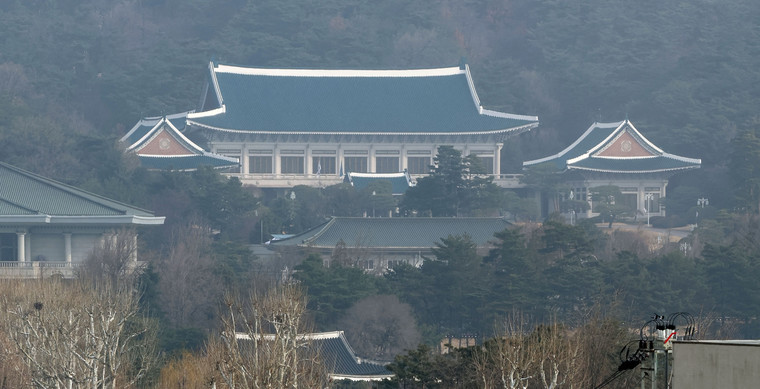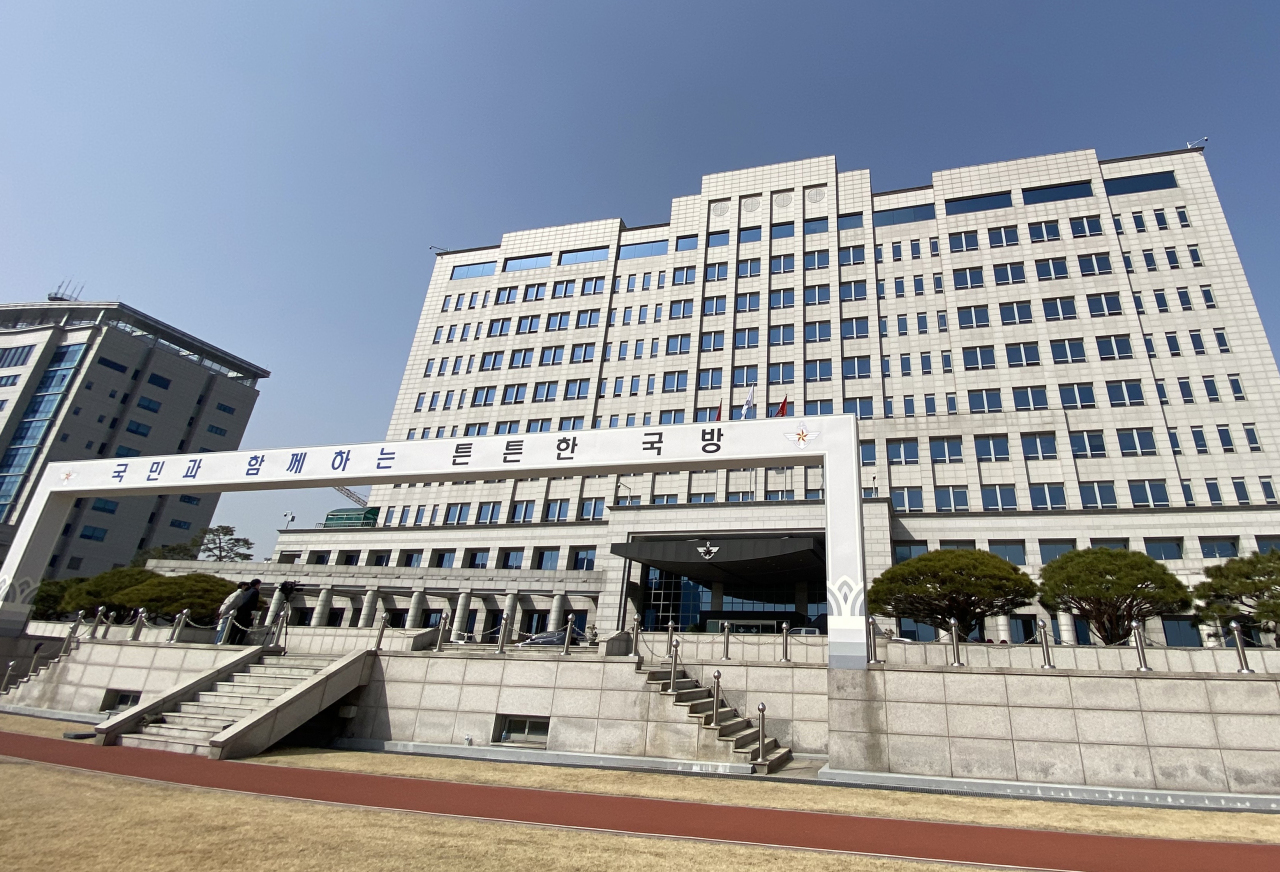 |
South Korea’s presidential office, Cheong Wa Dae, also known as the Blue House in Jongno, Seoul.(Yonhap) |
President-elect Yoon Suk-yeol is pushing hard with his plan to relocate the presidential office, with transition committee officials now saying there is zero possibility of him going to the current Cheong Wa Dae, also known as the Blue House due to its iconic blue-tiled roof.
From the start of his presidential campaign, Yoon has vowed to relocate the presidential office for “better communication” with the public, seeing Cheong Wa Dae as closed off from the public and a symbol of emperor-like presidential power.
Several sites are being considered as likely locations for the presidential office, with the Defense Ministry compound in Yongsan-gu, Seoul rising as a strong candidate. But wherever it would be, the plan is raising questions on feasibility -- as many hurdles of security, expense, and traffic efficiency -- are in the way.
Security of the president
One of the biggest concerns raised is the security of the president. Yoon inititally said he would move his presidential office to the Seoul Government Complex in the central Gwanghwamun area, not far from Cheong Wa Dae.
But a lack of the security facilities to protect the president emerged as a problem, and the president-elect has turned to the Defense Ministry compound in Yongsan-gu, near Samgakji Station in Seoul, as a plausible option.
The Defense Ministry compound, as a security facility itself, is expected to resolve the problem of the president’s safety. It already has protection facilities such as underground bunkers, according to Yoon’s aides.
For convenient transport, the compound also has helicopter takeoff and landing areas readied nearby.
However, as a divided nation with North Korea launching provocative missiles now and then, whether it is efficient for South Korea to transfer all of Cheong Wa Dae’s security features for Yoon’s relocation plan stands as a major question that needs to be addressed.
Cheong Wa Dae has an underground bunker stocked with top protection and intelligence equipment. National Security Council meetings are held at times of emergencies in this bunker.
Following the relocation plan, the president would have to either travel to Cheong Wa Dae from the Defense Ministry compound to attend an NSC meeting, or have it inside an underground bunker connected to the office of the Joint Chiefs of Staff.
Former Justice Party lawmaker Kim Jong-dae has pointed out that the underground bunker inside the headquarters of the Joint Chiefs of Staffs in the Defense Ministry compound is too small to accommodate the president and all related figures for an NSC meeting.
“In the case of an emergency, do they plan to kick out all the soldiers? Do they plan to hold the NSC meeting with everyone standing up?” Kim said on his Facebook on Wednesday.
The ruling Democratic Party of Korea also released a statement on Thursday, denouncing Yoon Suk-yeol’s push on relocation as “hasty and impellent,” and also causing a threat to national security.
“Not only is it preposterous to decide on the relocation in such hasty manner just two months before inauguration, it will also create many side effects and unnecessary chaos when they move the presidential office inside the Defense Ministry compound,” the ruling party lawmakers affiliated with the parliamentary committee for National Defense said in a statement.
 |
The Ministry of National Defense headquarters in Yongsan, Seoul (Yonhap) |
Cost and inconvenience
The cost of relocation has also become a subject of criticism from opponents. Only the prospects are laid out of the relocation costs, but it is estimated that it would cost some hundreds of billions of won.
The Ministry of the Interior and Safety has reported to Yoon’s presidential transition committee that it would cost about 50 billion won ($41 million) for the presidential office to be moved to the Defense Ministry compound in Yongsan. If the office is moved to Seoul Government Complex to take the place of the Foreign Ministry in central Gwanghwamun, it would reportedly cost about 100 billion won.
On Thursday, an online presidential petition was posted to criticize Yoon’s plan as “wasting an enormous amount of tax money.”
“President-elect Yoon Suk-yeol is talking of establishing a new presidential office all for his own satisfaction, and is forcing relocation of the security facilities and systems of the Defense Ministry that have been optimized for national security,” the anonymous petitioner wrote on the presidential petition site operated by the government.
“The presidential term lasts only for five years. The people can never agree to Yoon’s impellent demand to take over the Defense Ministry’s compound for his five years as the president, and also to spend tens of thousands of won to waste the taxpayer’s precious money.”
There is also the problem of serious traffic congestion, as the presidential residence would also be moved, but not at a walking distance.
Yoon’s transition team is reportedly looking into several options for the presidential residence, including the official residences of the Ministry of Foreign Affairs, the Army, Navy or Air Chief of Staff, and building a new residence nearby.
This would require adjustment to the traffic system in the area where the new presidential office would be located in, as the roads would have to be cleared off every time the president commutes to his office from the residence, or travels to another region.
Is relocation the answer?Yoon is adamant that his initiative to relocate the presidential office is for better communication with the public, and describes Cheong Wa Dae as an “isolated royal palace.”
In fact, Yoon is not the first one to try to relocate the presidential office out of Cheong Wa Dae.
The incumbent president Moon Jae-in had also pledged to move the presidential office to Gwanghwamun, to “eradicate the authoritative presidential culture,” and to “open the Gwanghwamun era,” as said in his first presidential bid in 2012.
After Moon came into office in 2017, the government carried out the discussion quite far -- even forming a presidential committee dedicated to the relocation project.
But the administration had to give up after a year and a half of review, after learning that they could not find adequate space for other affiliated facilities, such as a reception hall to accommodate VIPs from abroad, the headquarters, and heliports sites nearby.
Disputes remain over whether moving the presidential office to the Defense Ministry or other places is really the way to bring the president and the public closer together.
As for the example of the Defense Ministry compound, offices of the Joint Chiefs of Staff and other military facilities that would remain, even if some of the defense ministry offices are relocated to other venues.
This means that the envisioned presidential office inside the Defense Ministry compound would still be considered a military facility, with civilians prohibited from entering.
As Yoon has insisted that he would hold his inauguration ceremony not at Cheong Wa Dae, but at a new presidential office on May 10, it has created rumors that the strong drive behind the seemingly hurried relocation is based on Yoon’s belief in feng shui, or the geomantic evaluation of the land where Cheong Wa Dae is situated.
The feng shui evaluation of Cheong Wa Dae site appears to be divided. And the theory that the site has back luck has surfaced from time to time, as former presidents have all come to meet bad ends -- impeachment, corruption trials and more.
By Jo He-rim (
herim@heraldcorp.com)









